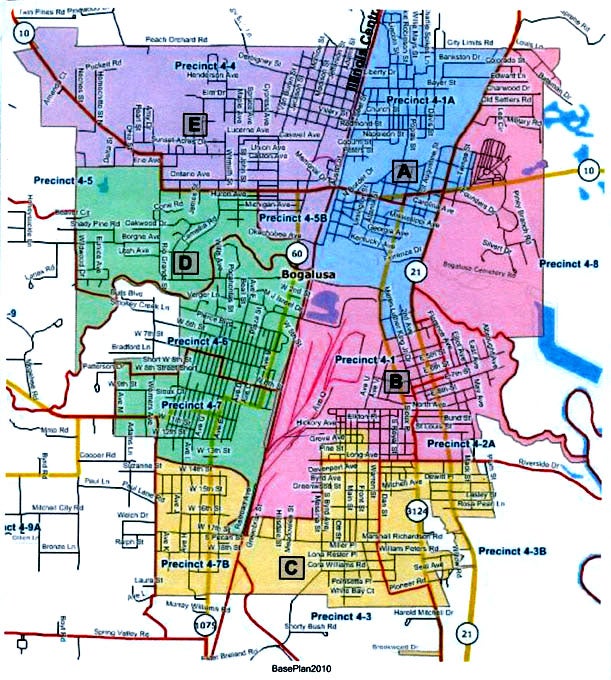Redistricting proposals presented
Published 9:33 pm Thursday, July 19, 2012
The chairman of the Washington Parish Election Commission presented a redistricting proposal to the Bogalusa City Council during its regular meeting Tuesday, and the council has until the end of the year to have its choice of the three plans approved by the state and the Justice Department.
The reapportionment of council districts is required within one year after every 10-year census if population shifts affect fair representation.
According to census figures, the population of Bogalusa dropped by 1,146 people, from 13,378 to 12,232, between 2000 and 2010.
In response, the mean population target per district has dropped to 2,446, and the state allows only a five percent plus or minus deviation.
All five council districts lost population, but the distribution of the loss was not uniform. District A, which is under the spread, and D, which is over, need to be changed, said WPEC Chairman Marshall Jenkins.
The city also went from 57 percent white and 43 percent minority population in 2000 to nearly 49 percent white and more than 51 percent minority. It lost 1,716 white residents and gained 570 minority residents in that decade.
As part of the redistricting plan, Bogalusa also needs to maintain the current “strong” minority majority council districts A and B and to create a third to reflect the current racial makeup of the city population, said Jenkins. It needs 2.57 or three minority districts, he said.
Marshall said he came up with five or six possible plans and whittled that number down to three, which he presented to the council Tuesday.
With adjustments based on updated census numbers,
Plan A would get Council District A into compliance with the addition of 249 people, 73 white and 176 minority, from voting precinct 4-1, and the subtraction of 68 people, 63 white and five minority, from precinct 4-8.
Council District B would gain the 68 people lost to District A, and lose 116 residents, 30 white and 86 minority, from precinct 4-1.
District C would gain 221 people, 167 white and 54 minority, from precinct 4-7, and lose 133 residents, 43 white and 90 minority, from precinct 4-1.
District D would be brought into compliance with a loss of 221 people, 167 white and 54 minority, from precinct 4-7.
Council District E would remain unchanged.
Under Plan B, District A would be brought into compliance with the addition of 42 people, four white and 38 minority, from precinct 4-1; the addition of 260 people, 158 white and 102 minority, from precinct 4-5B; and the loss of 68 people, 63 white and five minority, from precinct 4-8.
District B would gain 91 people, 39 white and 52 minority, from precinct 4-1. It would also gain 68 residents, 63 white and five minority, to encompass all of precinct 4-8. It would lose 237 people, three white and 234 minority, from precinct 4-2A.
District C would gain what District B lost in precinct 4-2A and lose 133, 43 white and 90 minority, in precinct 4-1.
District D would be brought into compliance with the subtraction of 162 people, 88 white and 74 minority, from precinct 4-5.
District E would gain what District D lost in precinct 4-5 and lose 260 people, 158 white and 102 minority, from precinct 4-5B.
Under Plan C, Council District A would gain 249 people, 73 white and 176 minority, from precinct 4-1, and lose 68 people, 63 white and five minority, from precinct 4-8.
District B would gain those lost to District A to include all of precinct 4-8, and lose 116 people, 30 white and 86 minority, from precinct 4-1.
District C would add 109 people, 101 white and eight minority, and encompass all of precinct 4-7, and 23 residents, all white, to also contain all of precinct 4-9A. It would lose 133 people, 43 white and 90 minority, from precinct 4-1.
District D would lose the 109 people in precinct 4-7 and the 23 residents in precinct 4-9A gained by District C.
District E would remain unchanged.
Jenkins said the state and Justice Department would likely approve any of the three plans, and would certainly approve Plan B, which the election commission recommends.
He said that the Justice Department would need a minimum of 60 days to complete the process. Therefore, with holidays factored in, the issue must be decided before November.
City residents will have a chance to check out and comment on the proposed plans during the public participation period of the next council meeting on Aug. 7.






